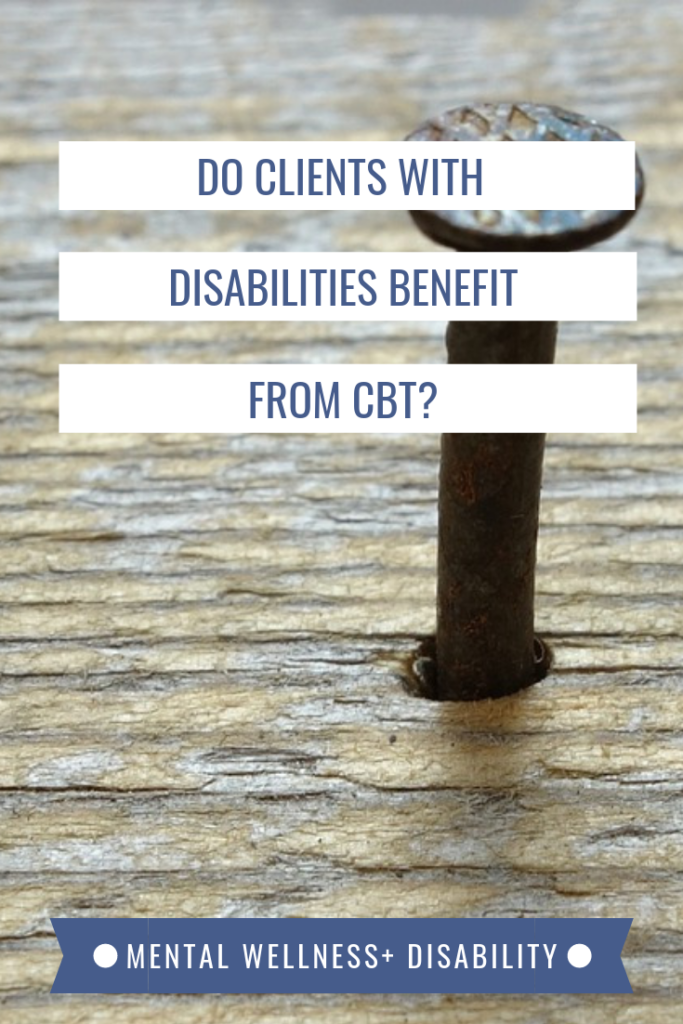When I introduce myself as a therapist who helps people with I/DD, most people think that I offer ABA therapy. They are often surprised to hear that I usually use CBT in my therapy sessions with clients with intellectual disabilities.

ABA versus CBT for people with disabilities
If you’re not sure what those acronyms mean, here’s a quick explanation of what they are and how they’re different.
ABA stands for Applied Behavior Analysis
ABA has been the most prevalent therapeutic technique used to support people with certain disabilities (especially Autism) since the 1960’s. This is a process of increasing desired, socially significant behaviors through the use of rewards or other positive reinforcements. At the same time, there is a focus on eliminating those behaviors that are harmful or maladaptive, such as self-injury, opposition/aggression, and stereotyped behaviors.
Oftentimes, those familiar with ABA will talk about DTT, which is Discreet Trial Training. This is a process of teaching complex behaviors and skills by breaking them down into smaller, more attainable steps, and then adding them together over time. It may also mean rewarding spontaneous behaviors that are part of a more complex desired behavior. The instructor shapes and chains the desired behaviors until the student masters the complete complex skill.
ABA relies heavily on reducing vague terms to observable, measurable terms. So, instead of “addressing a child’s aggression”, ABA therapy would focus on “eliminating all instances of attempting biting, scratching, and hitting”.
Many professional Autism support organizations endorse ABA therapy. Many research studies have found that ABA is a safe and effective intervention.
However, there is much debate about the value of ABA. Some providers of ABA have been accused by parents and students of using severe punishment to achieve consistent behaviors. Opponents say that ABA creates fearful robots, and not children choosing their behavior wisely.
CBT is Cognitive Behavioral Therapy
CBT is a psychotherapy approach that counselors use to treat a wide range of psychiatric conditions. This therapy technique is an effective treatment for Depression, Anxiety, Obsessive Compulsive Disorder, anger problems, and Post-Traumatic Stress Disorder, to name a few. It is the most commonly used evidence-based practice to treat mental health conditions.
In CBT, therapists help clients recognize that the way they think about themselves and their experiences influences how they feel. Thus, the goal of therapy is usually to identify and to change unhelpful thinking patterns as a way of managing emotional problems. The client eliminates disordered thought and behavior patterns as they learn new coping strategies.
Anyone licensed to provide mental health treatment may use CBT as a therapeutic technique. This includes Psychologists, Licensed Professional Counselors, Licensed Clinical Social Workers, etc.
My choice to provide CBT and not ABA
When I first realized that people with disabilities in the Triangle were in sore need of a therapist who understood them, I had some important choices to make.
First among these was what kind of therapist would be most helpful to the people I wanted to serve.
As I thought about the people with disabilities who I knew were suffering, I realized that it wasn’t their disability that was causing them pain.
It was their depression, or their anxiety, or their communication in social settings and relationships. In some cases, it was something more severe, like alcohol dependence. For others, they were simply feeling ill at ease about a transition coming up, like moving into their own apartment, finding a community job, or going to college.
Maybe their challenges in comprehension made it tough for them to identify what needed to change. To be sure, difficulty communicating their needs made it tougher to get the help they so desperately wanted. In short, disability made treatment trickier, yet, as I thought about the people I wanted to help, I saw that …
None of their stress had to do with their disability.
But because of their disability, no therapists felt they could help them with their stress.
My choice was practically made for me.
There are a lot of great ABA providers in our area.
But there were no therapists using other therapeutic modalities to help people with disabilities deal with mood disorders, relationships, addictions, or anything else outside of their disability.
I wanted to be that therapist. And so I set about learning how to provide the most effective Cognitive Behavioral Therapy to people with developmental and intellectual disabilities.
How to use CBT when clients have cognitive limitations
So, the burning question…how does a therapist make a cognitive based therapy work for people with cognitive limitations?
By making therapy equal parts experience and talk.
Experiential therapy makes CBT accessible to my clients with disabilities. I give my clients tangible ways to think about their cognitive processes and how their thoughts affect their emotions.
An illustrative example of experiential CBT
There’s an old ‘life lesson’ about a young boy who was perpetually angry, and who would erupt in anger at the slightest discomfort, screaming profanities and hateful words at his family.
His father made a new rule. Instead of having an outburst, when he felt angry, he was to take a 3 inch nail and hammer it into an old 4×4 piece of wood in their shed.
The first day under the new rule, the boy beat 30 nails into the piece of wood. This took great effort. It made his eyes sting with sweat, and gave him blisters on his hands. Over the next few days, he thought twice before getting angry. He started to consider whether his anger was worth the pain and hassle of driving a nail into a board.
Finally, there came a day when the boy added no new nails to the board.
His father congratulated him on learning to control his anger.
Then, he flipped the hammer around. He handed it to the boy, and told him to remove every nail he’d driven into the board.
When the boy finished, holes riddled the board. It was weak, and couldn’t be reliably used to build anything.
The father explained to the boy that his words had weight. That moving forward he could choose his words more wisely, but that hurtful things cannot be unsaid. They will always leave a mark. The boy couldn’t remove the nails without leaving behind evidence that they were once there. The harsh words the boys said in anger could be forgiven, but not forgotten.
How to make CBT therapy accessible for clients with disabilities
I keep this old parable in mind often as I consider what techniques will be most meaningful for my clients with intellectual disabilities.
I want them to leave therapy with a ‘board’ of their own. Something real, and tangible. A visual reminder that they have choices, and that they have made progress.
Here’s an example of a homework assignment I’ve used with clients with intellectual disabilities who have anxiety, but who are unwilling to make actionable changes to resolve their anxiety, to demonstrate a similar point.
I will give my client a collection of rocks or stones and a plastic sandwich bag.
I discuss with the client that each stone represents a worry they have throughout the day.
Together, the client and I each hold one stone.
We discuss that, alone, one worry is not particularly heavy or difficult to hold.
Then, I ask my client to make a cup with their hands, and I fill the client’s hands with the stones. Usually, a stone or two will fall to the ground as they try to keep them all together.
That’s ok.
What this demonstrates is that, if my client allows their worries to accumulate and tries to keep ‘holding it all together’, inevitably, something will slip.
CBT usually involves homework done outside of session
I then give my client a homework assignment. Each day, they should take their baggie and stones with them. Each time they have a worry that they ‘don’t want to deal with’, they should put a stone in the bag.
Just as when they tried to hold them all in their hands, they’ll experience that, while one stone is particularly tough to manage, trying to go about your day with a bag full of them in your pocket is quite uncomfortable and distracting. Just like worries that are not addressed.
Depending on the client’s intellectual capacity/writing ability/interest in the activity, etc., we may decide that they should use stickers to mark each stone with a label, to remind them of what the worry was.
Similarly, I may also give them a daily log to track their experiences, such as how many stones they collected, what worries they represented, how relieved they were to unburden themselves of the stones at the end of the day, etc.
At our next session, we now have ample opportunity to discuss the particular anxieties that the client experienced. The client has the language to discuss their own internal cognitive processes, and can use the real world equivalents of the stones or bag to represent their worries or their mind.
This helps the client begin to see the relationship between their thoughts, their feelings, and the things they do, which is the foundation of CBT.
Help me share this post with others who may want to learn about using Cognitive Behavioral Therapy with people with I/DD
I believe that CBT can be an effective intervention for people with Autism, Down syndrome, and other disabilities. If you agree with me, please use the social buttons to share this post. There are lots of people who don’t know that ABA isn’t their only option.
Keep reading
Other posts you may be interested in
How to Know if Someone is a Real Friend. A Quiz for Teens and Adults with IDD.
In my counseling practice, I offer mental health counseling for teens and adults with IDD. Many of my clients who have Down syndrome, Cerebral palsy, and other disabilities have lots of meaningful friendships in their lives. But sometimes, they ask “how can I know if someone is a real friend?” Maybe you have a friend […]











